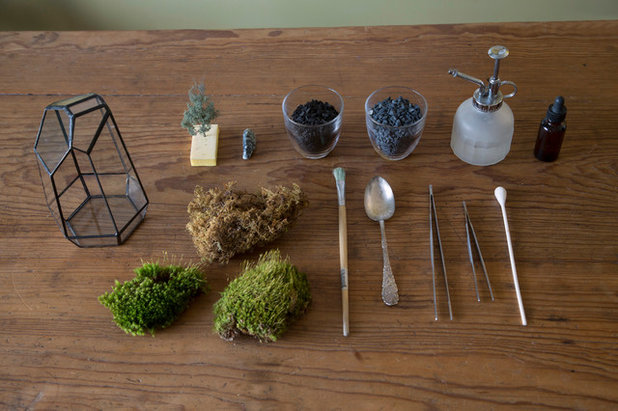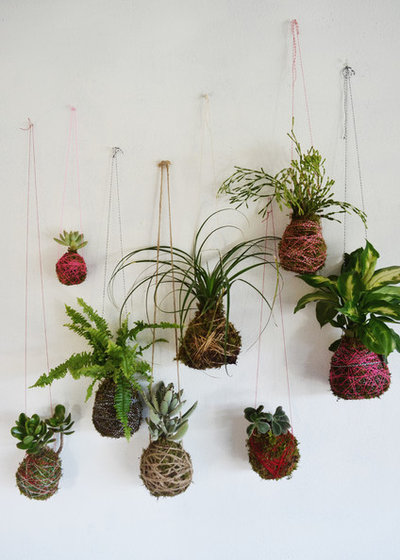There are no potted snake plants (
Sansevieria) or fiddleleaf figs (
Ficus lyrata)
here. These seven fresh DIY projects previously featured on Houzz will enliven your home with plants, and they won’t take you more than an afternoon to complete.

Margot Hartford Photography
1. Mini Moss TerrariumMoss often plays a supporting role in terrarium and houseplant DIYs, but in this project by Baylor Chapman it’s the star. Resting on a bed of rocks, the fuzzy patch of green can brighten many interior spaces. With people praising moss for its calming qualities, among other benefits, making this terrarium could also be a great way to take a break.

Margot Hartford Photography
Getting started: This simple project requires small stones, horticultural charcoal and a couple of moss types that will be layered in a glass vessel. Mementos such as collected rocks or figurines can be added for a one-of-a-kind terrarium. If given proper sun and water, it should last a long time.
See how to make this moss terrarium

Jaana Bithell
2. Petite Dinosaur PlanterSure, potted plants are attractive, but they can also be playful. These spray-painted dinosaur planters can be used indoors or out, depending on the plants you use, and make planting fun for the whole family. While these planters feature succulents and cactuses, the author says you could try herbs for an indoor garden.

Jaana Bithell
Getting started: Hollow plastic dinosaurs, or any other hollow plastic animal, serve as the vessels. You’ll also need a drill and a utility knife to cut each dinosaur open, plus spray paint, soil, plants and household tools to assist with cutting and painting.
While this project is quick, it does require using a drill, a utility knife and spray paint.
See how to make these mini dinosaur planters

Singing Gardens
3. Driftwood and Succulent CenterpieceThis project, made entirely of natural materials, puts eye-catching and resilient succulents up close, as a centerpiece or decorative wall piece. The designer made many of them for a wedding, but they can be enjoyed on an everyday table.
This project calls for driftwood, but there are plenty of other wood materials you could use in its place. Be sure to choose a piece with an interesting shape.

Singing Gardens
Getting started: Driftwood, succulents, air plants, potting mix and sphagnum moss make up the centerpiece. You’ll need an electric drill and drill bits of varying diameters, along with the necessary safety gear, to fashion your driftwood centerpiece.
Once the succulents have taken root, this centerpiece can also be hung vertically, indoors or out. While the designer says her succulents have done well in the driftwood centerpiece for more than six months, they also can be removed once they grow too large and planted in the ground or a larger container.
See how to make this long-lasting centerpiece

Ashley Camper Photography
4. ‘Kokedama’ String GardenThis Japanese-inspired hanging garden is a take on the Japanese art of bonsai. “
Kokedama” means “moss ball” in Japanese. This project, by floral designer Mandy Grace, incorporates a succulent or small fern in a ball of soil. It’s held together with moss and string and then hung indoors as a long-lasting houseplant.
While the designer says it’s a straightforward project, be sure to do it where you won’t mind getting a little messy.

Ashley Camper Photography
Getting started: Succulents and small ferns are great plants for string gardens. Additionally, you’ll need a mixture of peat soil, cactus soil and clay mud, plus sphagnum moss, cotton thread, packing string and a few household tools.
These plants will be grown indoors and will need to be watered somewhat regularly.
See how to make a string garden

Go Make Me
5. Teacup Planter PotIf you’re not sure what to do with that lone teacup you’ve saved over the years, or you’re looking for a different vessel to grow your kitchen herbs or small succulents in, give this teacup planter a try.

Go Make Me
Getting started: Grab an unused cup and saucer, or pick one up at a garage sale or thrift store. You’ll need to drill a drainage hole in the bottom of the cup with a 6-millimeter tungsten-tip diamond drill bit. The author suggests placing a piece of masking tape on the cup’s bottom to prevent the drill bit from slipping.
This planter can be used indoors or out, depending on what you plant in it and how much light exposure it will receive.
See how to make teacup planter pots

Alison Hodgson
6. Fantastic Fairy GardenOr perhaps it’s time for a fairy garden. This project is an easy-to-assemble whimsical container planting with garden accessories that will make any garden fairy feel at home. There’s a lot of room for creativity and personalization.

Alison Hodgson
Getting started: You’ll need a container for your fairy garden. The author used a large enamel pan, but you can substitute a tray, crate, wagon or terra-cotta pot. You’ll also need a light planting mix, small plants and fun accessories to lure the fairies — from path materials to furniture and a structure the fairies might live in.
See how to make this succulent fairy garden

Suzi Appel Photography
7. Star Wars TerrariumIn contrast to the moss terrarium seen earlier, this project by Adrian Weinberg is more of a miniature landscape under glass — complete with
Star Wars figurines on a re-created planet Endor.
It requires more specialized equipment than the others, and as a result will cost a little more up front.

Suzi Appel Photography
Getting started: You’ll start with an Exo-Terra terrarium, or similar, in which to build your landscape. You’ll also need a daylight plant globe, horticultural charcoal, sphagnum moss, peat moss, seiryu (rocks) and gold vine wood to build your terrarium base. The plants come next, and Weinberg suggests just letting the nursery staff know that you’re assembling a terrarium so they can recommend appropriate species.
See how to make a
Star Wars terrarium





